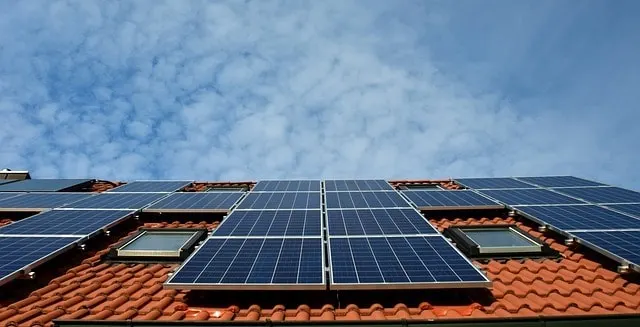 ____________________________________________________________________________
____________________________________________________________________________
The eco-conscious movement recently influenced the residential sector. Previous generations valued convenience over affordability, and today the standards changed. Now, individuals prioritize low-emission, sustainable home technology and practices.
Since President Biden took office, the government began prioritizing climate change prevention efforts. He extended renewable energy and sustainability tax incentives, helping citizens invest in clean electricity production. Homeowners can install green technology and adopt eco-conscious lifestyles, reducing environmental impacts and improving air quality.
1. Install Solar Panels
Installing photovoltaic (PV) solar panels on your roof can significantly reduce your greenhouse gas emissions. Unlike fossil fuel-driven power, PV devices rely on a non-depletable energy source. When solar radiation reaches a panel, photons release electrons from atoms.
Freed electrons generate an electrical circuit, creating an accessible power source. Adding a PV system to your home can eliminate the air pollutants associated with electricity use. Reducing greenhouse gas emissions can prevent rising global temperature, protecting natural resources and ecosystems.
It additionally improves localized air quality, reducing adverse health effects. Air pollution may cause wheezing, chest pains and asthma attacks. It also increases one’s risk of developing lung cancer.
Installing PV panels on your roof can shrink your carbon footprint and protect your family’s health. The system also eliminates electricity costs, helping homeowners save money.
2. Utilize Autonomous Learning Devices
When charged with solar energy, a smart speaker can improve a child’s learning experience sustainably. The device connects to the internet using WiFi, accessing a plethora of information. For working parents, the resource may reduce stress and improve the efficiency of their home lives.
Conducting schoolwork at home is challenging for many children. Fortunately, smart speakers can guide kids through challenging math problems or conduct practice quizzes. The voice automation feature helps individuals of varying ages and capabilities use the resource.
Electronic learning devices are more efficient than tutors because they eliminate transportation emissions. Some companies also prioritize sustainability, helping customers chose learning instruments through paperless catalogs. A reduction of materials and emissions increases the sustainability of home education.
3. Build a Vegetable Garden
Homeowners can also build a vegetable garden, further reducing greenhouse gas emissions. When you grow food on your property, you limit your trips to the grocery store. It also eliminates the emissions generated from transporting food from a farm to the packaging facility then the grocery store.
The transportation sector generates 29% of all US greenhouse gas emissions. Planting a vegetable garden can significantly shrink your carbon footprint. It may additionally limit your generation of plastic waste.
The food industry creates 14.5 million tons of plastic waste annually. Containers and packages consume 5% of the municipal solid waste (MSW) sector. Unfortunately, a significant quantity of plastic waste breaks down into microplastics, littering the ocean.
Microplastics cause ecosystem degradation when consumed by aquatic species. They also work their way up the food chain, ending up in the seafood we consume. Humanities consumption of plastic causes adverse health effects.
Homeowners can reduce their carbon emissions and increase the protection of the food chain by growing a vegetable garden. The food production method also decreases one’s exposure to pesticides, improving the cleanliness and safety of the food on their plate.
4. Install a Rainwater Harvesting System
Water exploitation also degrades the sustainability of a home. You can increase your protection of freshwater and shrink your water footprint by installing a rainwater harvesting system. Rather than sourcing your home’s water from a city line, you can collect and purify stormwater.
Rainwater harvesting systems collect stormwater in a barrel. It travels to an irrigation system for direct use or a filtration device for indoor use. After purification, a solar pump can deliver the potable source to faucets, showerheads and washing machines.
The sustainable system additionally reduces ecosystem exploitation by preventing runoff. In agricultural regions, rainwater travels off properties into fields, transporting pesticides and synthetic fertilizers to the ocean. The nitrogen-rich solution promotes algal blooms in aquatic areas.
As algae grow, they deplete localized oxygen levels, leaving marine regions uninhabitable. As dead zones expand, aquatic species become endangered, limiting their protection and food resources. You can reduce your contribution to eutrophication by installing a rainwater harvesting system.
5. Use a Smart Thermostat
Installing a smart thermostat can decrease your home emissions related to heating and cooling. The device controls your heating, ventilation and air conditioning (HVAC) system, increasing its energy efficiency. Smart thermostats use WiFi, accessing local weather predictions.
When it is cool outside, the system turns the air conditioning down, conserving power. It also utilizes motion detection sensors, turning the HVAC system off in a vacant home. Over time, the reduction in temperature control energy use shrinks a homeowner’s carbon footprint.
6. Swap Conventional Bulbs with LED Lights
LED lights are another green feature residents may add to their homes. Conventional incandescent bulbs consume high quantities of energy. They also burn out quickly, generating a significant amount of waste.
The LED alternative requires 75% less electricity, generating fewer carbon emissions. The bulbs also last 25 times longer than traditional lights, conserving landfill space. Reducing the pollution associated with your home increases its sustainability and cleanliness.
The Future of Green Homes
Various cities work towards carbon neutrality by implementing ambitious residential and commercial building standards. Some regions require renewable energy sources and low-emission appliances on properties. As Biden continues his climate change prevention work, he may establish national sustainability regulations in the residential sector.
Installing sustainable devices and adopting an eco-conscious lifestyle can prepare homeowners for the transition. Improving your home for emission reductions additionally increases its value on the market. If you plan on selling your property in the coming years, you may consider adding sustainable devices now.
- Sagittarius Man & Gemini Woman Love and Sex Compatibility - January 31, 2024
- Taurus Ascendant Rising Personality Traits in Men (Guide) - January 31, 2024
- How to Seduce and Attract a Sagittarius Man (Seduction Tips) - January 31, 2024
